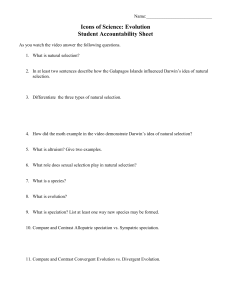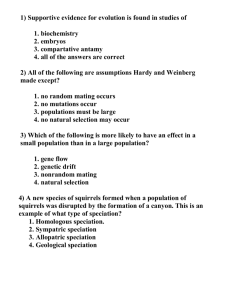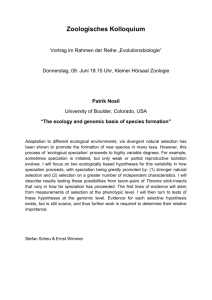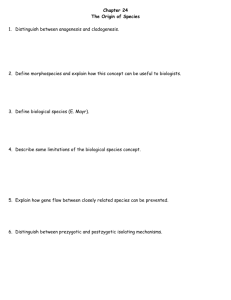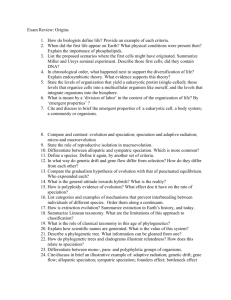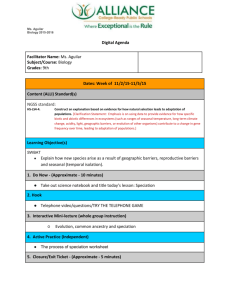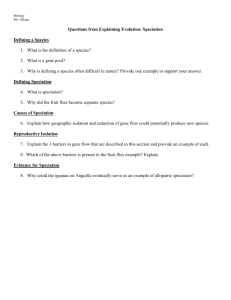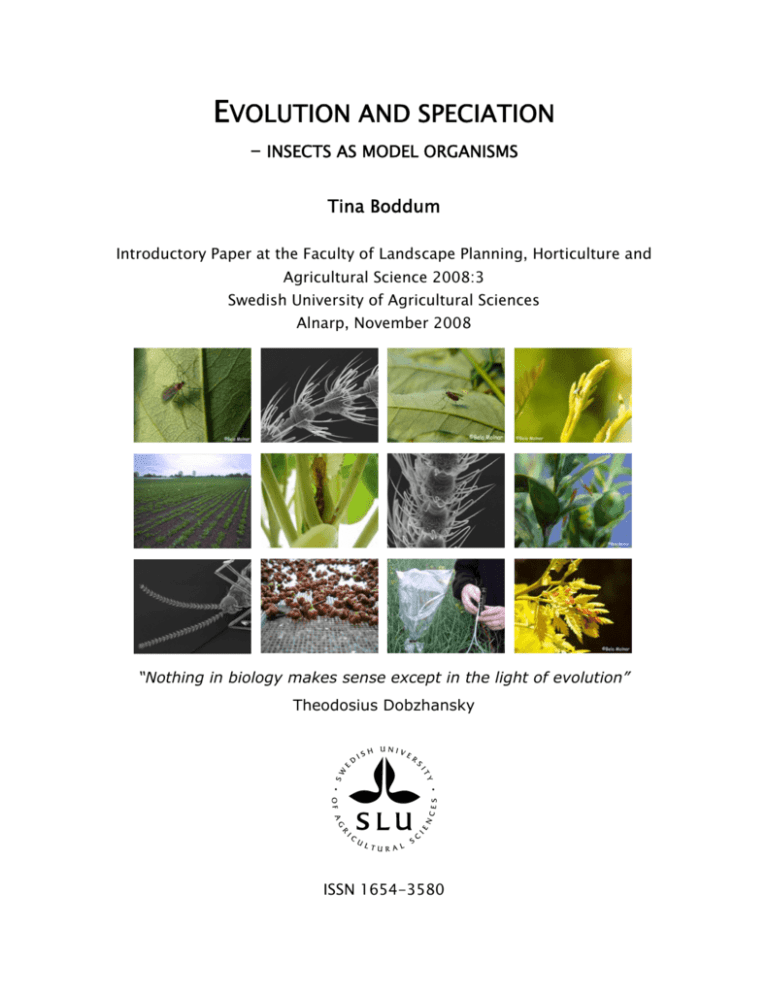
EVOLUTION AND SPECIATION
- INSECTS AS MODEL ORGANISMS
Tina Boddum
Introductory Paper at the Faculty of Landscape Planning, Horticulture and
Agricultural Science 2008:3
Swedish University of Agricultural Sciences
Alnarp, November 2008
“Nothing in biology makes sense except in the light of evolution”
Theodosius Dobzhansky
ISSN 1654-3580
2
EVOLUTION AND SPECIATION
- INSECTS AS MODEL ORGANISMS
Tina Boddum
Introductory Paper at the Faculty of Landscape Planning, Horticulture and
Agricultural Science 2008:3
Swedish University of Agricultural Sciences
Alnarp, November 2008
“Nothing in biology makes sense except in the light of evolution”
Theodosius Dobzhansky
3
4
1. Preface
This introductory paper is part of my PhD project: “Host shift induced speciation in gall midges”.
The project is conducted at the Swedish University of Agricultural Sciences (Alnarp), department
of Plant Protection Biology, division of Chemical Ecology. The project is part of IC-E3,
supported by a Linnaeus Grant (Formas, Sweden). My supervisors are Ylva Hillbur, Bill S.
Hansson and Göran Birgersson. The first part of this paper is a general overview of evolution and
speciation. This is followed by a more detailed part about insects and their speciation. At the end
of the paper the gall midges (Diptera: Cecidomyiidae) are introduced.
2. Summary
Charles Darwin is the father of evolution as we know it today. In his book “The origin of
species” he states that new species originate from ancestral species that change over time, and
that the mechanism of the change is natural selection. How the variation natural selection need is
generated and passed from generation to generation was solved by Gregor Mendel and Thomas
Hunt Morgans (and his group). Based on experiments with pea plants, Mendel formed laws about
segregation and assortment of traits and Morgans group demonstrated that Mendels hypothetical
factors are specific points on the chromosome.
Evolution mostly deals with how populations become adapted to their environment, but not how
this adaption leads to speciation. For speciation to occur, barriers for the gene flow between
populations have to evolve. There are two general modes of speciation defined by how the gene
flow between populations is interrupted. In allopatric speciation a physically barrier isolates a
population, whereas sympatric speciation occur within a single geographical area and
reproductive isolation arises between individuals that always have the opportunity to interbreed.
Insects are good models when the mechanisms underling evolution and speciation are studied,
there are more than one million species and their diversity and distribution is amazing. Olfaction
is the primary sense by which the environment is interpreted by insects, and olfactory cues can be
5
6
important for separation of population evolving in sympatry. That was demonstrated by Löfstedt
and co-workers who studied nine species of sympatric ermine moth Yponomeuta. All species had
a mixture of (E)-11 and (Z)-11 tetradecenyl acetate as primary pheromone compounds, however,
the females produced the compounds in a specific ratios that never overlapped if the species were
not isolated by other barriers.
Pheromones are well studied compared to the plant-produced odors. However, insects can detect
relevant plant odors with the same selectivity and sensitivity as they detect pheromones. The
number of volatiles emitted from fruit and plants is much higher than the number of components
in the female pheromone, yet, Stensmyr et al. (2003) demonstrated that Drosophila melanogaster
only needs a few key components to locate and detect a food source.
The Rhagoletis pomonella sibling species complex is a model system for sympatric host race
formation and speciation (e.g. Forbes et al., 2005; Linn et al., 2003; Linn et al., 2005b). The
complex consists of several strains with different host preference – a preference based on
olfactory cues. Host choice is of evolutionary significance for Rhagoletis as they mate on or near
the fruit of their respective host plant. Adult flies tend to mate on or near the same species of host
fruit as the one they infested as larvae. Thus, differences in host preferences can translate into
mate choice and can act as pre-mating barriers to gene flow.
As for other insects, gall midge behavior has been shown to be guided by olfactory cues; they use
pheromones when locating a suitable mate and plant volatiles for host plant recognition. Thus,
host plant volatiles might be important when gall midges shift between hosts and subsequently in
the formation of new gall midge species. In my thesis I will study possible evolutionary
mechanisms behind the great diversity of the gall midges. The two main questions I will address
in my thesis are: do gall midges associated with the same host plant use the same or a similar set
of odors to identify it? And, conversely, do closely related species that have different host plant
requirements respond to odors common for the different plants?
7
8
1. PREFACE
5
2. SUMMARY
5
3. EVOLUTION
11
3.1 THE IDEAS
3.2 LEVEL OF SELECTION
3.3 MORE THAN GENES?
11
13
13
4. SPECIATION
14
4.1 SPECIES CONCEPTS
4.2 ISOLATION OF POPULATIONS
4.3 TYPES OF SPECIATION
4.3.1 ALLOPATRIC SPECIATION
4.3.2 SYMPATRIC SPECIATION
4.4 PHYLOGENETIC RELATIONSHIP
16
17
18
18
19
20
5. INSECTS AS MODELS IN EVOLUTION
21
5.1 PLANT INSECT INTERACTIONS
21
6. EXAMPLES OF INSECT EVOLUTION AND SPECIATION
22
6.1 SEX PHEROMONES AND REPRODUCTIVE ISOLATION IN MOTHS
6.2 DROSOPHILA AND OLFACTION
6.3 RHAGOLETIS AND SYMPATRIC SPECIATION
6.3.1 THE SIBLING SPECIES COMPLEX
6.3.2 TUNED TO THE NATAL FRUIT
6.3.4 INHERITANCE OF HOST PREFERENCES
6.4 THE GALL MIDGES
6.4.1 LIFE-HISTORY STRATEGIES
6.4.2 GALL MIDGE SPECIATION
22
23
25
25
26
28
28
29
30
REFERENCES
32
9
10
3. Evolution
Evolution is one of the most unifying concepts in biology, as any aspect of an organism – from
mating behaviour to the mode of photosynthesis or a mutation in a gene – can be explained from
an evolutionary perspective (Grimaldi and Engel, 2005).
3.1 The ideas
Charles Darwin (1809-1882) is the father of evolution as we know it today (Campbell et al.,
1999a; Horan, 2006). His book “The origin of species” is the basis for modern evolution and
speciation theories. Darwin proposed that new species originate from ancestral species that
change over time. He added the mechanism of evolutionary change – natural selection (Freeman
and Herron, 2004; Grimaldi and Engel, 2005). Alfred R. Wallace (1823-1913) had the ideas
independent of Darwin, and was co-author with Darwin on the original paper proposing natural
selection as the mechanism behind evolution (Freeman and Herron, 2004; Grimaldi and Engel,
2005).
Darwin’s theory is based on four postulates from the introduction to “The Origin of species”
(Table 1; Darwin, 1859). Darwin regarded life in nature as a competition, where the fittest
individuals win. The fitness of an individual refers to how well it survives and reproduces
compared to other individuals in the population. Traits that increase the fitness of an organism
relative to individuals without those traits makes it better adapted (Campbell et al., 1999a;
Freeman and Herron, 2004). However, Darwin could not explain how variation was passed from
generation to generation and how it was generated. That was solved by Gregor Mendel (18221884) and Thomas Hunt Morgan’s (1866-1945) group at Columbia University. Based on
experiments with pea plants, Mendel formed laws about segregation and assortment of traits
(Freeman and Herron, 2004; Grimaldi and Engel, 2005) and Morgan’s group demonstrated that
Mendel’s hypothetical factors are specific points on the chromosome (Allen, 1985a; Allen,
1985b).
11
Table 1. Darwin’s original postulates about evolution as stated in “the Origin of species” and the postulates re-stated
after the Modern Synthesis (Freeman and Herron, 2004).
Darwin’s postulates in the “the Origin of species”
Re-statement after the Modern Synthesis
1. Individuals within populations are variable
1. As a result of mutations creating new
alleles, and segregation and independent
assortment
shuffling
alleles
into
new
combinations, individuals within populations
are variable for many traits
2. The variations among individuals are, at least in
2. Individuals pass their alleles to their
part, passed from parents to offspring
offspring intact
3. In every generation, some individuals are more
3. In every generation, some individuals are
successful at surviving and reproducing than others
more successful at surviving, and reproducing
than others
4. The survival and reproduction of individuals are not
4. The individuals that survive and reproduce,
random; instead they are tied to the variation among
or reproduce the most, are those with the
individuals. The individuals with the most favorable
alleles and allelic combinations that best adapt
variations, those who are better at surviving and
them to their environment.
reproducing, are selected for.
In the 1920s Darwinian selection and Mendelian inheritance were integrated into the Modern
Evolutionary Synthesis by Dobzhansky, Mayr, Simpson and Stebbins (Campbell et al., 1999b;
Grimaldi and Engel, 2005; Freeman and Herron, 2004; Table 1). The synthesis emphasizes the
importance of populations as the unit of evolution; it states that mutations are the source of raw
material for evolutionary change, that natural selection is the most important mechanism of
evolution, and that large changes can evolve as accumulation of small changes occurring over
long periods of time.
The classical Darwinian theories and the Modern Synthesis are now challenged, but these
theories have shaped most current ideas about evolution.
12
Figure 1. Some of the great thinkers in the history of evolution and speciation (from left to right): Charles Darwin
(1809-1882), Gregor Mendel (1822-1884), Thomas Hunt Morgan (1866-1945) Ernst Walter Mayr (1904-2005,
Theodosius Grygorovych Dobzhansky (1900-1975).
3.2 Level of selection
A central evolutionary concern is what unit is actually selected (Campbell et al., 1999a; Dawkins,
1976; Jablonka and Lamb, 2006). There are two general ways of looking at natural selection
from: the gene's angle and that of the individual. The classical way is focusing on the individual,
but Dawkins (1976) introduced the gene's view of nature. Dawkins argued that genes and not the
whole organism is the unit of natural selection. The organisms are just “survival machines” for
the genes. However, the strictly gene-centered concept of natural selection is maybe also too
simplistic, and the two ways are probably equivalent (Freeman and Herron, 2004; Jablonka and
Lamb, 2006). Natural selection acts on phenotypes, but for evolution to occur there must be
genetic variation that natural selection can act on.
3.3 More than genes?
The phenotype of an individual is traditionally regarded as the summation of two totally
independent factors: the genes and the environment (Jablonka and Lamb, 2006). However, after
the introduction of epigenetic variation the separation is less clear. Epigenetic variation is
inherited variation that is sensitive to environmental input (Jablonka and Lamb, 2006; Lindqvist
et al., 2007; Richards, 2006). Traditionally, it was believed that inherited information only
changes at random and without direction towards a particular phenotypic outcome, but recent
13
findings indicate that the environment can affect the genotype (Hoy, 2003). The most well known
example is transposable elements. Transposable elements are elements (with an RNA or DNA
intermediate) that can move from site to site in the genome (Hoy, 2003). The activity of the
elements can be induced by environmental factors, especially stress (Capy et al., 2000). This
suggests that transposable elements can create new genetic variation that is useful under
conditions where the fitness of an organism is reduced (Capy et al., 2000; Hoy, 2003). The
evolutionary significance of epigenetic mechanisms was first discovered in plants where the
adaptive significance is clear (Jablonka and Lamb, 2006). Plants cannot avoid harsh conditions
by moving away and epigenetics might allow them to respond in another way (Jablonka and
Lamb, 2006).
4. Speciation
Despite the title of his book, Darwin devoted little space for the origin of species (Campbell et
al., 1999a; Coyne, 1994). He concentrated on how populations become adapted to their
environment through natural selection, but not how this adaption leads to speciation (Campbell et
al., 1999a; Coyne, 1994). Now, the study of speciation is one of the most active areas of
evolutionary biology, and progress has been made in documenting and understanding phenomena
in all aspects of speciation (Turelli et al., 2001). However, there is a fundamental problem in the
field. It is very difficult to define exactly what “species” is. “It is as if on one hand we know just
what “species” means, and on the other hand, we have no idea what it means” (Hey, 2001)
The idea of organic discontinuity has a long tradition, beginning with Linnaeus’ classification
(Coyne, 1994). The clustering of organisms into discrete groups (i.e. species) can be seen both in
morphology, gene sequences and reproductive compatibility (Turelli et al., 2001). However,
some biologists argue that the discontinuities are artefacts of human perception (Coyne, 1994),
and in some groups e.g. in plants and asexually reproductive taxa, it is difficult to separate
different species (Coyne, 1994; Turelli et al., 2001).
14
But why will organisms cluster into groups separated by gaps? And what properties of sexually
reproducing organisms and their environment lead to the evolution of discrete species? Two (not
mutually exclusive) explanations exist: the “ecological explanation” and the “sexual isolation
explanation” (Coyne and Orr, 2004; Turelli et al., 2001). The ecological explanation states that
ecological niches are discrete and that the clusters result from the ways different species exploit
physical resources. Furthermore, disruptive selection (Figure 2D) makes hybrids that “fall
between niches" less fit. The sexual isolation explanation states that groups will adapt different to
the environment. Over time the number of differences will increase (divergent evolution) and
result in the formation of new species (Coyne and Orr, 2004).
A
B
C
D
Figure 2. Three general modes of selection. A) The original population. B) Stabilizing Selection: Intermediate traits
are favored by selection, resulting in a decrease in variation. C) Directional Selection: One extreme trait is favored,
resulting in a change in the mean value of the trait. D) Disruptive Selection: Extreme traits are favored over the
intermediate trait values, can divide the population into two distinct groups. Disruptive selection plays an important
role in speciation (http://www.sparknotes.com/).
15
4.1 Species concepts
The biological species concept is a classical and widely accepted species concept (Berlocher,
1998; Campbell et al., 1999b). It defines a species as a group of actually or potentially
interbreeding populations that are reproductively isolated from other such groups (i.e. they have
the same gene pool). New species arise when the evolution of reproductive isolation mechanisms
prevents gene exchange between populations (Turelli et al., 2001, Campbell et al., 1999c).
Population biologists are discovering more and more cases where the biological species concept
is not valid e.g. in asexual organism where the concept of breeding does not make sense. That
results in the development of several other species concepts (Box 1) (Campbell et al., 1999a;
Coyne, 1994; Coyne and Orr, 2004; Grimaldi and Engel, 2005).
Box 1. The biological species concept and some proposed alternatives (Campbell et al., 1999a; Coyne, 1994; Coyne
and Orr, 2004)
Biological species concept: Emphasizes reproductive isolation. Species are groups
of actually or potentially interbreeding natural populations that are reproductively
isolated from other such groups
Cohesion species concept: Focuses on mechanisms that maintain species as
discrete phenotypic entities. Each species is defined by its complex of genes and set
of adaptations. Applicable to organisms that reproduce without sex
Ecological species concept: Defines species on the basis of where they live and
what they do
Evolutionary species concept: A species is a single lineage of ancestral and
descendant populations that are evolving independently of other such groups.
Genotypic cluster species concept: A species is a (morphologically or genetically)
distinguishable group of individuals that has few or no intermediates when in
contact with other such clusters
Morphological species concept: Defined species by measurable anatomical
differences (morphological criteria). It is practical to apply in the field, even to
fossils.
Phylogenetic species concept: A species is the smallest monophyletic group of
common ancestry
Recognition species concept: Emphasizes mating adaption’s that become fixed in a
population as individuals “recognize” certain characteristics of suitable mates
16
4.2 Isolation of populations
Speciation in sexually reproductive organisms is based on the evolution of reproductive barriers
for the gene flow between populations (Campbell et al., 1999b; Turelli et al., 2001). Barriers can
occur before mating, between mating and fertilization, or after fertilization (Figure 3). Prezygotic
barriers occur before fertilization (figure 3) (Campbell et al., 1999b; Coyne and Orr, 2004). A
common prezygotic barrier is habitat isolation, where a geographical barrier (e.g. flooding) can
divide a population into several isolated populations (Campbell et al., 1999b)
Postzygotic barriers exercise isolation after
fertilization (Figure 3; Table 2). The isolation
can be divided into extrinsic postzygotic and
instrinsic postzygotic (Campbell et al., 1999b;
Coyne and Orr, 2004; Turelli et al., 2001). In
extrinsic postzygotic isolation, hybrids are unfit
because they “fall between” parental niches as
they have an intermediate phenotype that is less
fit (Coyne and Orr, 2004). In intrinsic
postzygotic
isolation,
hybrids
suffer
developmental defects that make them unable to
survive or develop normally (Coyne and Orr,
2004).
Figure 3. The reproductive barriers that prevent gene flow
between two different species. Prezygotic barriers occurs
before mating, while postzygotic do after (Campbell et
al., 1999b).
17
Table 2. Classification of postzygotic reproductive isolation (Coyne and Orr, 2004)
Extrinsic
Ecological inviability: Hybrids develop normally but suffer decreased viability, as they cannot find a suitable
ecological niche
Behavioral sterility: Hybrids have normal gametogenesis but suffer lowered effective fertility because they
cannot find mates. Hybrids might have an intermediate courtship behavior or other phenotypes that render them
unattractive to individuals of the opposite sex.
Intrinsic
Hybrid inviability: Hybrids have developmental defects causing full or partial inviability.
Hybrid sterility:
Physiological sterility: Hybrids suffer developmental defects in their reproductive system causing full or
partial sterility.
Behavioral sterility: Hybrids suffer a neurological defect that renders them fully or partially incapable of
courtship
4.3 Types of speciation
There are two general modes of speciation: allopatric speciation and sympatric speciation (Figure
4). They are defined by how the gene flow among populations is interrupted. In allopatric
speciation a geographical barrier physically isolates a population and initially blocks gene flow,
whereas in sympatric speciation intrinsic factors e.g. chromosomal changes or nonrandom mating
alter the gene flow.
Mode of speciation
New species formed
Allopatric
allo = other,
patric = place
From geographically isolated
populations
Sympatric
sym = same,
patric = place
within the range of the
ancestral population
Figure 4. The two general modes of speciation. Top) allopatric speciation. Bottom) sympatric speciation
4.3.1 Allopatric speciation
In allopatric speciation populations are separated by geographical isolation. In allopatric
speciation extrinsic factors – as great distance or a physical barrier – prevents two or more groups
from mating (Campbell et al., 1999b). Physical isolation is an effective barrier to gene flow and
18
in many cases it is an important trigger for divergence. When no forces impose reproductive
capability between isolated populations the populations will, given enough time, become
incompatible (Turelli et al., 2001). Allopatric speciation is most likely to occur if a small
population in the periphery of a species’ range gets isolated. The individuals in the periphery are
often extremes with a gene pool that differs from that of the rest of the population (Campbell et
al., 1999b; Freeman and Herron, 2004). In a small population random mutations or new
combinations of existing alleles with neutral adaptive value may get fixed by chance and
evolution by natural selection may be different than in the parent population (Campbell et al.,
1999b).
4.3.2 Sympatric speciation
Since the nineteenth century it has been debated if speciation requires geographical isolation
(Berlocher, 1998). The authorities (e.g. Mayr and Dobzhansky) argued that geographic isolation
is a necessary first step for divergence in animals whereas Guy Bush emphasized ecological
adaption as an important factor in speciation (Bush, 1998; Feder et al., 2005). Sympatric
speciation is still questioned and recent analyses show that allopatric speciation is the most
common mode (Barraclough and Nee, 2001).
Two central factors differ between sympatric and allopatric speciation. Firstly, sympatric
speciation does not require large-scale geographic distance to reduce gene flow between parts of
a population (Campbell et al., 1999b; Freeman and Herron, 2004). Instead new species arise
within the range of the parent population as the result of reproductive barriers between the mutant
and the parent populations. Secondly, in sympatric speciation gene flow may continue for a
number of generations after the populations have become separated, whereas complete isolation
arises between populations evolving in allopatry.
A four stage series has been proposed for sympatric speciation via host plant shift for
phytophagous insects (Berlocher, 1998): (1) partially reproductively isolated host races (2)
species isolated only by host fidelity (3) species with partial prezygotic and/or postzygotic
isolation unrelated to host fidelity and (4) totally reproductively isolated species.
19
4.4 Phylogenetic relationship
Phylogenetic classification is the most useful type
of systematics (Grimaldi and Engel, 2005).
Organisms are analyzed and divided into a
hierarchical pattern (a cladogram or phylogenetic
tree) based on homologies in behavior, morphology
or
molecular
traits
(Box
2;
Hoy,
2003;
Plesiomorphi: similarities that arose in a
distant common ancestor (ancestral or
“primitive”)
Apomorphic: similarities that arose in a
resent common ancestor (derived or
“advanced”)
Box 2. Classification of characteristics
(Grimaldi and Engel, 2005; Hoy, 2003)
Schoonhoven et al., 2005)
Phylogenetic classification allows interpretation of evolutionary patterns e.g. explanations for
creation and termination of lineages (Grimaldi and Engel, 2005). Species can be divided into
monophyletic, polyphyletic and paraphyletic groups based on the associations of their ancestors
(Figure 5), however, classification must be strictly monophyletic to have any explanatory power
(Grimaldi and Engel, 2005).
Monophyletic group
Containing all the descendants of a
hypothetical common ancestor
Polyphyletic group
Containing the descendants of a
common ancestor that retain shared
primitive characters, but omitting
descendants that have lost those
characters
Paraphyletic group
A monophyletic group that excludes
some of the descendants
Figure 5. Phylogenetic classification, species are divided into monophyletic, polyphyletic and paraphyletic groups.
20
5. Insects as models in evolution
Insects were among the first animals on land, and the diversity and distribution of now living
insects is astonishing. With one million species, insect are the most diverse organisms in the
history of life – both in numbers of species and variety of structures and behaviors (Grimaldi and
Engel, 2005; Schoonhoven et al., 2005)
5.1 Plant insect interactions
Several hypotheses that explain the diversity of herbivorous insects have been proposed
(Schoonhoven et al., 2005). One theory is that herbivorous insects and their host plants are
involved in “an arms race” through reciprocal evolution/co-evolution. The first plants are older
than the first insects, but the currently largest group of plants – the angiosperms – evolved in the
Cretaceous period where insects were abundant. It is, however, debated if the plants are affected
by the herbivorous insects or if the insects just follow the evolution of the plants.
The evolution of host-plant choice can be illustrated with cladograms showing the correlation
between insect and host-plant phylogenies (Table 3; Schoonhoven et al., 2005).
Table 3. Four types of cladogram illustrations of the divergence of existing plant and insect species from their
ancestors are found. Type B and C suggest polygenetic conservatism – that speciation in herbivorous insects is often
accompanied by shifts between closely related plant taxa.
Type
Insects
Specificity of insects
Host plants
A
Closely related
Oligophagous/monophagous
Distantly related
B
Closely related
Oligophagous/monophagous
Closely related
C
Closely related
Monophagous
Closely related
D
One species
Polyphagous
Distantly related
Cladogram: Insects
Plants
21
6. Examples of insect evolution and speciation
6.1 Sex pheromones and reproductive isolation in moths
Species-specific sex pheromones can provide reproductive isolation in moths. The specificity of
the sex pheromone is achieved by specific compounds or by a specific ratio of compounds
(Hansson, 1995). The pheromone is typically produced and released by the female with males of
the same species perceiving the pheromone and flying upwind to the female (Karlson and
Lüscher, 1959; Linn and Roelofs, 1995).
The evolution of the complex pheromones might be the result of the requirement for a distinctive
signal in an environment where several species use the same or similar compounds (Linn and
Roelofs, 1989; Löfstedt, 1993). Insects might show varying degrees of specificity depending on
the contact with closely related species (Linn and Roelofs, 1989; Löfstedt, 1993).
Löfstedt and co-workers examined nine species of the small ermine moth Yponomeuta living
sympatrically in Europe (Löfstedt and Herrebout, 1988; Löfstedt and Vanderpers, 1985). All
species had a mixture of (E)-11 and (Z)-11 tetradecenyl acetate as primary pheromone
compounds. The females produced the compounds in specific ratios, however, some species
produced the same ratio (Figure 6) (Löfstedt, 1986; Löfstedt et al., 1991). Nevertheless, the range
did only overlap for species that were isolated by other barriers e.g. lived on different host-plant,
was temporally separated or had an additional pheromone component.
The pheromone (and the capacity to respond to it) is directly associated with reproductive success
(Löfstedt, 1986). The female emitting the species specific pheromone blend will be most
attractive for the majority of males and the males responding to the common pheromone has the
possibility to mate with most females (Löfstedt, 1986). If there is risk for hybridization,
additional separation can evolve e.g. the pheromone component from one species act as
behavioral antagonists to other species (Löfstedt et al., 1991). Pheromone blends can be the
primary barrier for gene flow and separate populations in sympatry (Linn and Roelofs, 1989;
22
Löfstedt, 1993) or the pheromone can be of secondary importance and isolate populations that
already are diverged in allopatry (Löfstedt, 1993).
Figure 6. Graphic model of niche separation in the small ermine moth. The pheromone contains a mixture of two
acetates (Z11 and E11-14:OAc), however the ratio is not species specific. If there is overlap along the Z/E-axis
additional separation occurs e.g. temporal or spatial (Löfstedt, 1986).
6.2 Drosophila and olfaction
Drosophila is a model insect when speciation is studied. The data from Drosophila are unique –
and are likely to remain so – because of the large number of crossable species and the ease of
creating sexual and postzygotic isolation in the laboratory (Coyne and Orr, 1997; Coyne and Orr,
1989; Dodd, 1989).
D. melanogaster has been used to study how speciation affects the olfactory system (e.g. Dekker
et al., 2006; Mcbride and Arguello, 2007; Rkha et al., 1991; Stensmyr, 2004). The D.
melanogaster group contains closely related species occupying widely different niches. In
addition, the species also display varying food preferences, with species ranging from single host
23
specialists to true generalists (Hoy, 2003). Surprisingly, the olfactory system has to a large extent
stayed unchanged over evolutionary time (Stensmyr, 2004).
Compared to the pheromone system – which for each insect only includes a few compounds – the
number of volatiles emitted from fruit and plants is much higher, e.g. 230 different from banana
(Macku and Jennings, 1987). Still, the insect’s plant odor-detecting olfactory receptor neurons
(ORNs) can match pheromone ORNs with respect to selectivity and sensitivity (Hansson et al.,
1999; Larsson et al., 2001; Stensmyr et al., 2001).
Stensmyr et al. (2003) demonstrated that D. melanogaster only needs a few key components to
locate and detect food. D. melanogaster is primarily feeding on rotting fruit; hence the key
components are general fruit volatiles (e.g. ethyl hexanoate) as well as acetoin which indicate
microbial activity. Additionally, D. melanogaster detects key volatiles that indicate an unsuitable
resource that for drosophila are green leaf volatiles like 1-hexanol that signal unripe fruit
(Stensmyr et al., 2003).
A few species exist where changes in the
olfactory system has occurred, e.g. D. sechellia
which has the Morinda citrifolia fruit as its only
host plant. The morinda fruit has a high acid
content and is toxic to all Drosphila species
except for D. sechellia (Rkha et al., 1991). D.
sechellia has adapted by loss of the olfactory
receptors that respond to common fruit volatiles
(ab2) in return for more receptors (ab3) that
respond to the esters emitted from the Morinda
fruit (Stensmyr et al., 2003).
Such a specialization can be the adaption to
Figure 7. Stress full conditions and to populations
changes in the environment. Dodd (1984; 1989)
adapting in allpatri can result in two separate species.
demonstrated that one population can be forced to
(http://evolution.berkeley.edu/evosite/evohome.html)
24
separate into two, by rearing them under stressful conditions. She divided a population of D.
pseudoobscura into two groups that were reared on either a starch-based medium or a maltosebased medium (Dodd, 1984; Dodd, 1989). Both media where stressful and it took the populations
several months to become established (Dodd, 1984). After adaption, individuals from the
different groups could no longer reproduce as they were isolated by behavioral barriers (Figure
7). Hence, the selection for individuals adapted to the food had also affected the genes involved
in reproductive behavior (Dodd, 1989).
6.3 Rhagoletis and sympatric speciation
6.3.1 The sibling species complex
The Rhagoletis pomonella Wash (Diptera: Tephritidae) sibling species complex is a model
system for sympatric host race formation and speciation, and often cited as an example of host
race formation in action (Forbes et al., 2005; Linn et al., 2003; Linn et al., 2005b). R. pomonella
recently shifted from its ancestral host hawthorn (Crataegus spp) to domesticated apple (Malus
pumila) which was introduced to the eastern United States in the mid-1800s (Figure 8).
Figure 8. Rhagoletis and its two hosts in the eastern United States: apple (left) and hawthorn (right).
(http://www.sciencecases.org/maggot_fly/images/emergence.gif).
A third Rhagoletis fly that infests flowering dogwood, Cornus florida L (Cornaceae) has been
hypothesized to be the sister taxon to R. pomonella. The hawthorn population is presumed to be
ancestral, thus the dogwood and apple populations have evolved their preferences independently
(Berlocher, 1999; Berlocher, 2000).
25
6.3.2 Tuned to the natal fruit
Rhagoletis use volatile compounds emitted from the surface of fruit to recognize their host plants
(Table 4) (Nojima et al., 2003a; Nojima et al., 2003b; Zhang et al., 1999). The majority of
individuals from a given host population has a strong preference for their natal fruit compared to
non-natal fruit (Linn et al., 2003; Linn et al., 2005; Linn et al., 2004) e.g. the derived apple fly
race has evolved an increased preference for apple fruit volatiles and decreased the response to
hawthorn volatiles (Linn et al., 2003). However, within each population there is a proportion
(10%-30%) of broad responders that are attracted both to their natal blend and one or more nonhost blends. This variability in host discrimination is possibly the basis for the sympatric host
race formation in Rhagoletis (Linn et al., 2005b). Host choice is of evolutionary significance for
Rhagoletis as they mate on or near the fruit of their respective host plant (Feder and Filchak,
1999; Linn et al., 2003). Adult flies tend to mate on or near the same species of host fruit as the
one they infested as larvae. Thus, differences in host preferences can translate into mate choice
and can act as pre-mating barriers to gene flow (Feder, 1994, 1998, Forbes et al., 2006).
Table 4. Key volatiles attracting Rhagoletis pomonella from Dogwood, Hawthorn and Apple (Nojima et al., 2003a;
Nojima et al., 2003b; Zhang et al., 1999).
Flowering dogwood
Hawthorn
Apple
Chemical
1-Octen-3-ol
3-Methylbutan-1-ol
4,8-dimethyl-1,3(E),7-nonatriene
-Caryophyllene
Betyl hexanoate
Butyl butanoate
Dihydro--ionone
Dimethyl trisulfide
Ethyl acetate
Hexyl butanoate
Isoamyl acetate
Pentyl hexanoate
Propyl hexanoate
Key volatiles from:
% in blend
9.1
27.5
% in blend
% in blend
Rhagoletis pomonella origin from:
Dogwood
4.0
0.07
5.8
0.01
37
10
0.10
1.9
54.9
94.3
0.9
1.5
44
5
4
Hawthorn
Apple
The attraction to the host blend is antagonized when certain non-host volatiles are added to the
host blend (Linn et al., 2005a). Especially, the attraction of the apple flies to the apple blend can
be antagonized by adding key volatiles from hawthorn and dogwood (Figure 9) (Dambroski et
al., 2005; Linn et al., 2005a).
26
These findings indicate that the properties of fruit volatiles are similar to the properties of
pheromones. The male sensory system is highly tuned to the conspecific female – her pheromone
components are highly attractive while similar pheromone components from other species are
repellent. In the same way, attractive volatiles from the host plant and the repellent volatiles from
the non-host plant might increase the ability of Rhagoletis to find its host plant and decrease the
time spent searching for a host.
Surprisingly, single sensillum recordings revealed that all fly races can detect the same volatiles
(Olsson et al., 2006a). However, there is variability in the sensitivity and temporal firing of the
ORNs (Olsson et al., 2006c). The ORNs (both within and between populations) have a breadth of
variation in sensitivity to all volatiles (Olsson et al., 2006c). The variability in peripheral
sensitivity might influence host preferences and contribute to host fidelity, but can also be the
basis for a sympatric host shift. In ancestral populations the variability would provide a greater
array from which changes in response to blends could emerge and facilitate the acceptance and
subsequent colonization of a new host.
Figure 9. Most individuals from a given host population have a strong preference for their natal fruit blend
compared to non-natal volatiles. However, the attraction is antagonized when certain non-host volatiles is added to
the host blend (Adapted from Dambroski et al., 2005).
27
6.3.4 Inheritance of host preferences
Both single-sensillum recordings (Olsson et al., 2006b) and behavioral experiments (Dambroski
et al., 2005; Linn et al., 2004) show that F1 hybrid flies responded differently to host plant
volatiles compared to the parent populations. This indicates that fruit odor discrimination has a
genetic basis (Dambroski et al., 2005; Linn et al., 2004). Since a part of the F2 hybrids mirrored
the response of the parental flies, host discrimination is regulated by only a few genes
(Dambroski et al., 2005).
The altered response of the hybrids might be caused by an alteration in the expression of the
olfactory receptor neurons (Baker et al., 2006; Olsson et al., 2006b). The axon from the olfactory
neuron targets the glomeruli in the antennal lobe (Anton and Homberg, 1999; Bargmann, 2006;
Vosshall et al., 2000). The projection is specific; receptors that express the same receptor protein
convert on the same glomerulus independently of how the receptors are distributed on the
antenna (Anton and Homberg, 1999; Bargmann, 2006). This construction entails that a simple
change in receptor expression can lead to a shift in perception of odors i.e. if they are attractive or
repellent.
In nature, the hybrids have a reduced ability to detect and orient to host fruit (Dambroski et al.,
2005; Linn et al., 2004). This is a fitness disadvantage compared to non-hybrids, as they can not
locate a suitable host and – as mating is linked to the host – a suitable mate. This might contribute
to the reproductive isolation of new races in the complex, as host specific mating might serve
both as a postzygotic and a premating barrier.
6.4 The gall midges
The family Cecidomyiidae (Diptera), the gall midges, contains more than 5000 described species
(Gagné, 2004). They form galls on almost all plant parts, and are widely distributed among host
plants (Gagné, 1989). They are of evolutionary interest because of their rapid rate of speciation
compared to related families of Diptera (Foster et al., 1991). At the generic level, the gall midges
are often polyphagous – especially in the large genera as Asphondylia and Contarinia. However,
at species level many gall midges are monophagous or oligophagous (Yukawa et al., 2005). Gall
28
midges are unusual among phytophagous insects as closely related species can be associated with
different parts of a single host-plant (Gagné, 1989; Joy and Crespi, 2007).
6.4.1 Life-history strategies
The life span of adult midges can be as short as 1-2 h, but is commonly 1-2 days (Harris and
Foster, 1999). Within this limited time, the midges have to locate a mating partner, mate and the
females have to locate a suitable oviposition place.
Gall midges have different life-history strategies depending on where and how they overwinter
(Tokuda and Yukawa, 2007; Yukawa, 2000). Type IA and IB species overwinters as full grown
larvae in the ground, without or with the gall respectively. Type IIA and IIB overwinters in the
galls attached to the plant, either as mature or as immature larvae.
Mated females migrate
The female oviposit on the plants
And the larvae develop on the plant
Adults mate where they emerge
The mature larvae overwinters in the soil, and due to crop rotation
next years generation might emerge far away from its host plant
Figure 10. General life cycles for type I gall midges
29
6.4.2 Gall midge speciation
Speciation of plant-feeding insects is typically associated with host-plant shift followed by
divergent selection and adaption to the conditions associated with the new plant (Berlocher,
2000; Funk et al., 2002; Groman and Pellmyr, 2000). However, there are examples of gall
midges that speciate without a host plant shift (Joy and Crespi, 2007; Yukawa et al., 2005).
Instead, speciation occurs when the gall midges associate with new parts of the host-plant e.g.
move from leaf to stem (Joy and Crespi, 2007; Yukawa et al., 2005). The shift to a new plant part
does not require as extensive evolutionary changes as the stressful shift to a new host plant (Joy
and Crespi, 2007). Instead, within-host speciation might be facilitated by change in diapause
timing and less intraspecific competition for oviposition sites (Joy and Crespi, 2007).
Within-host speciation occurs in type II gall midges. Type II gall midges are closely associated
with the host plant in all stage of their live cycle, and several generation occurs in the same place.
In contrast, type I gall midges only live part of their life cycles on the host plant (Figure 10) and
do not display host specific mating (Readshaw, 1965; Summers, 1975; Thygesen, 1966). After
overwintering and mating at the emergence site, mated females migrate to the oviposition site on
the host plant (Readshaw, 1965; Summers, 1975; Thygesen, 1966). For gall midges associated
with agriculture, the female often have to migrate relatively long distances (due to crop rotation)
and is then guided by olfactory cues (Birkett et al., 2004; Galanihe and Harris, 1997; Pettersson,
1976). This is a crucial step in the gall midge lifecycle. The ability of the female to locate a
suitable place to oviposit determines the survival chances of the offspring. Despite the
importance of the oviposition choice, gall midges sometimes lay eggs on unfamiliar host plant or
host plant parts (Larsson and Ekbom, 1995; Larsson and Strong, 1992; Yukawa et al., 2008;
Åhman, 1981). The survival chance of the larvae is low on the alternative hosts but not always
zero (Yukawa et al., 2008). The development time of the larvae depends on the properties of the
host plant and can vary on different plants (Linkosalo, 2000; Mahoro, 2002). That can result in
temporal isolation of the emerging adults – a possible first step in sympatric speciation (Feder
and Filchak, 1999). Thus, a possible mechanism for speciation in type II gall midges is a
combination of oviposition mistakes and variation in the developmental time on different plants.
30
31
References
ALLEN, GE. 1985a. Morgan, Thomas, Hunt Materialism and Experimentalism in the
Development of Modern Genetics. Trends in Genetics. 1(6):186-190.
ALLEN, GE. 1985b. Thomas Hunt Morgan: Materialism and Experimentalism in the
Development of Modern Genetics .1. Trends in Genetics. 1(5):151-154.
ANTON, S. and HOMBERG, U. 1999. Antennal lobe structure, pp. In Hansson B. (eds.). Insect
olfaction. Springer, Berlin.
BAKER, TC., QUERO, C., OCHIENG, SA., and VICKERS, NJ. 2006. Inheritance of olfactory
preferences II. Olfactory receptor neuron responses from Heliothis subflexa x Hetliothis
virescens hybrid male moths. Brain Behavior and Evolution. 68(2):75-89.
BARGMANN, CI. 2006. Comparative chemosensation from receptors to ecology. Nature.
444(7117):295-301.
BARRACLOUGH, TG. and NEE, S. 2001. Phylogenetics and speciation. Trends in Ecology &
Evolution. 16(7):391-399.
BERLOCHER, SH. 1998. Origins. A brief history of research on speciation, pp. 470, In Howard
DJ. and Berlocher SH. (eds.). Endless forms. Species and speciation. Oxford University
Press, Oxford.
BERLOCHER, SH. 1999. Host race or species? Allozyme characterization of the 'flowering
dogwood fly', a member of the Rhagoletis pomonella complex. Heredity. 83:652-662.
BERLOCHER, SH. 2000. Radiation and divergence in the Rhagoletis pomonella species group:
Inferences from allozymes. Evolution. 54(2):543-557.
BIRKETT, MA., BRUCE, TJA., MARTIN, JL., SMART, LE., OAKLEY, J., and WADHAMS,
LJ. 2004. Responses of female orange wheat blossom midge, Sitodiplosis mosellana, to
wheat panicle volatiles. Journal of Chemical Ecology. 30(7):1319-1328.
BUSH, GL. 1998. The conceptual radicalization of an evolitionary biologist, pp. In Howard DJ.
and Berlocher SH. (eds.). Endless forms. Oxford University Press, Oxford.
CAILLAUD, MC. and VIA, S. 2000. Specialized feeding behavior influences both ecological
specialization and assortative mating in sympatric host races of pea aphids. American
Naturalist. 156(6):606-621.
CAMPBELL, N., REECE, J., and MITCHELL, L. 1999a. Descent with modification: a
Darwinian view of life in Biology in Biology. Benjamin/Cummings. California. USA.
414-427 p.
CAMPBELL, N., REECE, J., and MITCHELL, L. 1999b. The origin of species, pp. 445-463,
(eds.). Benjamin/Cummings, California. USA.
CAPY, P., GASPERI, G., BIEMONT, C., and BAZIN, C. 2000. Stress and transposable
elements: co-evolution or useful parasites? Heredity. 85(2):101-106.
COYNE, JA. 1994. Ernst Mayr and the origin of species. Evolution. 48(1):19-30.
COYNE, JA. and ORR, AH. 1997. ''Patterns of speciation in Drosophila'' revisited. Evolution.
51(1):295-303.
COYNE, JA. and ORR, AH. 2004. Speciation. Sinauer Associates. Massachusetts. USA. 545 p.
COYNE, JA. and ORR, HA. 1989. Patterns of Speciation in Drosophila. Evolution. 43(2):362381.
32
DAMBROSKI, HR., LINN, C., BERLOCHER, SH., FORBES, AA., ROELOFS, W., and
FEDER, JL. 2005. The genetic basis for fruit odor discrimination in Rhagoletis flies and
its significance for sympatric host shifts. Evolution. 59(9):1953-1964.
DAWKINS, R. 1976. The selfish gene. Oxford University Press Inc. New York. 360 p.
DEKKER, T., IBBA, I., SIJU, KP., STENSMYR, MC., and HANSSON, BS. 2006. Olfactory
shifts parallel superspecialism for toxic fruit in Drosophila melanogaster sibling, Dsechellia. Current Biology. 16(1):101-109.
DODD, DMB. 1984. Behavioral correlates of the adaptive divergence in Drosophila populations.
. Ph.D Diss. Yale Univ., New Haven, CT.
DODD, DMB. 1989. Reproductive Isolation as a Consequence of Adaptive Divergence in
Drosophila-Pseudoobscura. Evolution. 43(6):1308-1311.
FEDER, JL. and FILCHAK, KE. 1999. It's about time: the evidence for host plant-mediated
selection in the apple maggot fly, Rhagoletis pomonella, and its implications for fitness
trade-offs in phytophagous insects. Entomologia Experimentalis Et Applicata. 91(1):211225.
FEDER, JL., XIE, XF., RULL, J., VELEZ, S., FORBES, A., LEUNG, B., DAMBROSKI, H.,
FILCHAK, KE., and ALUJA, M. 2005. Mayr, Dobzhansky, and Bush and the
complexities of sympatric speciation in Rhagoletis. Proceedings of the National Academy
of Sciences of the United States of America. 102:6573-6580.
FORBES, AA., FISHER, J., and FEDER, JL. 2005. Habitat avoidance: Overlooking an important
aspect of host-specific mating and sympatric speciation? Evolution. 59(7):1552-1559.
FREEMAN, S. and HERRON, J. 2004. Evolutionary analysis. Pearson Prentic Hall. Upper
Saddle River.
FUNK, DJ., FILCHAK, KE., and FEDER, JL. 2002. Herbivorous insects: model systems for the
comparative study of speciation ecology. Genetica. 116(2-3):251-267.
GAGNÉ, RJ. 1989. The plant-feeding gall midges of North America. Cornell University Press.
Ithaca.
GAGNÉ, RJ. 2004. A catalog of the cecidomyiidae (diptera) of the world. The Entomological
Society of Washington. Washington, D.C.
GALANIHE, LD. and HARRIS, MO. 1997. Plant volatiles mediate host-finding behavior of the
apple leafcurling midge. Journal of Chemical Ecology. 23(12):2639-2655.
GRIMALDI, D. and ENGEL, M. 2005. Evolution of the insects. Cambridge university press.
New York. USA. 755 p.
GROMAN, JD. and PELLMYR, O. 2000. Rapid evolution and specialization following host
colonization in a yucca moth. Journal of Evolutionary Biology. 13(2):223-236.
HANSSON, BS. 1995. Olfaction in Lepidoptera. Experentia. 51:1003-1027.
HANSSON, BS., LARSSON, MC., and LEAL, WS. 1999. Green leaf volatile-detecting olfactory
receptor neurones display very high sensitivity and specificity in a scarab beetle.
Physiological Entomology. 24(2):121-126.
HARRIS, MO and FOSTER, S. 1999. Gall midges pp 27-49, in Hardie J, Minks AK (eds.)
Pheromones of non-lepidopteran insects associated with agricultural plants. CAB
international, Oxford, UK.
HEY, J. 2001. The mind of the species problem. Trends in Ecology & Evolution. 16(7):326-329.
HORAN, P. 2006. Foreword pp. In Darwin C. (eds.). The origin of species. Random House,
New York.
HOY, M. 2003. Insect molecular genetics. Academic Press. San Diego, USA. 544 p.
33
JABLONKA, E. and LAMB, M. 2006. Evolution in four dimensions. The MIT Press. London.
England. 462 p.
JOY, JB. and CRESPI, BJ. 2007. Adaptive radiation of gall-inducing insects within a single hostplant species. Evolution. 61(4):784-795.
KARLSON, P. and LÜSCHER, M. 1959. "Pheromones": a new term for a class of biologically
active substances. Nature. 183(55-56).
LARSSON, MC., LEAL, WS., and HANSSON, BS. 2001. Olfactory receptor neurons detecting
plant odours and male volatiles in Anomala cuprea beetles (Coleoptera : Scarabaeidae).
Journal of Insect Physiology. 47(9):1065-1076.
LARSSON, S. and EKBOM, B. 1995. Oviposition Mistakes in Herbivorous Insects - Confusion
or a Step Towards a New Host Giant. Oikos. 72(1):155-160.
LARSSON, S. and STRONG, DR. 1992. Oviposition Choice and Larval Survival of DasineuraMarginemtorquens (Diptera, Cecidomyiidae) on Resistant and Susceptible SalixViminalis. Ecological Entomology. 17(3):227-232.
LINDQVIST, C., JANCZAK, AM., NäTT, D., BARANOWSKA, I., LINDQVIST, N.,
WICHMAN, A., LUNDEBERG, J., LINDBERG, J., TORJESEN, PA., and JENSEN, P.
2007. Transmission of Stress-Induced Learning Impairment and Associated Brain Gene
Expression from Parents to Offspring in Chickens. PLoS ONE. 2(4):e364.
LINKOSALO, T. 2000. Mutual regularity of spring phenology of some boreal tree species:
predicting with other species and phenological models. Canadian Journal of Forest
Research-Revue Canadienne De Recherche Forestiere. 30(5):667-673.
LINN , C., FEDER, JL., NOJIMA, S., DAMBROSKI, HR., BERLOCHER, SH., and ROELOFS,
W. 2003. Fruit odor discrimination and sympatric host race formation in Rhagoletis.
Proceedings of the National Academy of Sciences of the United States of America.
100(20):11490-11493.
LINN, C., NOJIMA, S., and ROELOFS, W. 2005a. Antagonist effects of non-host fruit volatiles
on discrimination of host fruit by Rhagoletis flies infesting apple (Malus pumila),
hawthorn (Crataegus spp.), and flowering dogwood (Cornus florida). Entomologia
Experimentalis Et Applicata. 114(2):97-105.
LINN , C. and ROELOFS, W. 1995. Pheromone communication in moths and its role in the
speciation process, pp. 263-300, In Lambert DM. and Spencer HG. (eds.). Speciation and
the recognition concept. The Johns Hopkins University Press, London.
LINN, CE., DAMBROSKI, H., NOJIMA, S., FEDER, JL., BERLOCHER, SH., and ROELOFS,
WL. 2005b. Variability in response specificity of apple, hawthorn, and flowering
dogwood-infesting Rhagoletis flies to host fruit volatile blends: implications for sympatric
host shifts. Entomologia Experimentalis Et Applicata. 116(1):55-64.
LINN , CE., DAMBROSKI, H., NOJIMA, S., FEDER, JL., BERLOCHER, SH., and ROELOFS,
WL. 2005. Variability in response specificity of apple, hawthorn, and flowering
dogwood-infesting Rhagoletis flies to host fruit volatile blends: implications for sympatric
host shifts. Entomologia Experimentalis Et Applicata. 116(1):55-64.
LINN, CE., DARNBROSKI, HR., FEDER, JL., BERLOCHER, SH., NOJIMA, S., and
ROELOFS, WL. 2004. Postzygotic isolating factor in sympatric speciation in Rhagoletis
flies: Reduced response of hybrids to parental host-fruit odors. Proceedings of the
National Academy of Sciences of the United States of America. 101(51):17753-17758.
LINN, CE. and ROELOFS, WL. 1989. Response Specificity of Male Moths to Multicomponent
Pheromones. Chemical Senses. 14(3):421-437.
34
LINN, CE. and ROELOFS, WL. 1995. Pheromone Communication in Moths and Its Role in the
Spaciation Process, pp. 267-272 In Lambert DM. and Spencer HG. (eds.). Speciation and
the recognition concept. Theory and application. The Johns Hopkins University Press,
Baltimore.
LÖFSTEDT, C. 1986. Sex pheromones and reproductive isolation in moths. Ent. Tidskr.
107:125-137.
LÖFSTEDT, C. 1993. Moth Pheromone Genetics and Evolution. Philosophical Transactions of
the Royal Society of London Series B-Biological Sciences. 340(1292):167-177.
LÖFSTEDT, C., HERREBOUT, W., and MENKEN, S. 1991. Sex pheromones and their
potential role in the evolution of reproductive isolation in small ermine moths
(Yponomeutidae). Chemoecology 2:20-28.
LÖFSTEDT, C. and HERREBOUT, WM. 1988. Sex-Pheromones of 3 Small Ermine Moths
Found on the European Spindle Tree. Entomologia Experimentalis Et Applicata.
46(1):29-38.
LÖFSTEDT, C. and VANDERPERS, JNC. 1985. Sex-Pheromones and Reproductive Isolation in
4 European Small Ermine Moths (Lepidoptera-Yponomeutidae Latr). Journal of
Chemical Ecology. 11(5):649-666.
MACKU, C. and JENNINGS, W. 1987. Production of volatiles by ripening bananas. J. Agric.
Food Chem. 35:845-848.
MAHORO, S. 2002. Individual flowering schedule, fruit set, and flower and seed predation in
Vaccinium hirtum Thunb. (Ericaceae). Canadian Journal of Botany-Revue Canadienne
De Botanique. 80(1):82-92.
MCBRIDE, CS. and ARGUELLO, JR. 2007. Five drosophila genomes reveal nonneutral
evolution and the signature of host specialization in the chemoreceptor superfamily.
Genetics. 177(3):1395-1416.
NOJIMA, S., LINN, C., MORRIS, B., ZHANG, AJ., and ROELOFS, W. 2003a. Identification of
host fruit volatiles from hawthorn (Crataegus spp.) attractive to hawthorn-origin
Rhagoletis pomonella flies. Journal of Chemical Ecology. 29(2):321-336.
NOJIMA, S., LINN, C., and ROELOFS, W. 2003b. Identification of host fruit volatiles from
flowering dogwood (Cornus florida) attractive to dogwood-origin Rhagoletis pomonella
flies. Journal of Chemical Ecology. 29(10):2347-2357.
OLSSON, S., LINN, CE., and ROELOFS, WL. 2006a. The chemosensory basis for behavioral
divergence involved in sympatric host shifts. I. Characterizing olfactory receptor neuron
classes responding to key host volatiles. Journal of Comparative Physiology aNeuroethology Sensory Neural and Behavioral Physiology. 192(3):279-288.
OLSSON, SB., LINN, CE., MICHEL, A., DAMBROSKI, HR., BERLOCHER, SH., FEDER,
JL., and ROELOFS, WL. 2006b. Receptor expression and sympatric speciation: unique
olfactory receptor neuron responses in F-1 hybrid Rhagoletis populations. Journal of
Experimental Biology. 209(19):3729-3741.
OLSSON, SB., LINN, CE., and ROELOFS, WL. 2006c. The chemosensory basis for behavioral
divergence involved in sympatric host shifts II: olfactory receptor neuron sensitivity and
temporal firing pattern to individual key host volatiles. Journal of Comparative
Physiology a-Neuroethology Sensory Neural and Behavioral Physiology. 192(3):289-300.
PETTERSSON. 1976. Ethology of Dasyneura Brassicae winn. (dipt. cecidomyidae). I.
Laboratory studies of olfactory reactions to the host-plant. Symp. Biol. Hung.(16):203208.
35
READSHAW, J. 1965. The ecology of the swede midge, Contarinia nasturtii (Kieff.) (Diptera,
Cecidomyiidae).I. – Life-history and influence of temperature and moisture on
development. Bulletin of Entomological Research. 58:25-29.
RICHARDS, EJ. 2006. Opinion - Inherited epigenetic variation - revisiting soft inheritance.
Nature Reviews Genetics. 7(5):395-U2.
RKHA, S., CAPY, P., and DAVID, JR. 1991. Host Plant Specialization in the DrosophilaMelanogaster Species Complex - a Physiological, Behavioral, and Genetic-Analysis.
Proceedings of the National Academy of Sciences of the United States of America.
88(5):1835-1839.
SCHOONHOVEN, JM., VAN LOON, JJA., and DICKE, M. 2005. Insect-Plant Biology. Oxford
university press. Oxford. 421 p.
STENSMYR, MC. 2004. The fly nose - function and evolution. Alnarp. Sweden: Swedish
University of Agricultural Sciences 50 p.
STENSMYR, MC., DEKKER, T., and HANSSON, BS. 2003. Evolution of the olfactory code in
the Drosophila melanogaster subgroup. Proceedings of the Royal Society of London
Series B-Biological Sciences. 270(1531):2333-2340.
STENSMYR, MC., LARSSON, MC., BICE, S., and HANSSON, BS. 2001. Detection of fruitand flower-emitted volatiles by olfactory receptor neurons in the polyphagous fruit chafer
Pachnoda marginata (Coleoptera : Cetoniinae). Journal of Comparative Physiology aNeuroethology Sensory Neural and Behavioral Physiology. 187(7):509-519.
SUMMERS, C. 1975. Daily adult emergence in the sorghum midge, Contarinia sorghicola.
Environmental entomology 4:495-498.
THYGESEN, T. 1966. Krusesygegalmyggen (Contarinia nasturtii Kieff.). Undersøgelse af
biologi og økonomiske betydning samt forsøg med bekæmpelse. . Tidsskrift for planteavl.
. 70. :179-197.
TOKUDA, M. and YUKAWA, J. 2007. Biogeography and evolution of gall midges (Diptera :
Cecidomyiidae) inhabiting broad-leaved evergreen forests in oriental and eastern
Palearctic regions. Oriental Insects. 41:121-139.
TURELLI, M., BARTON, NH., and COYNE, JA. 2001. Theory and speciation. Trends in
Ecology & Evolution. 16(7):330-343.
WOJTASEK, H., HANSSON, BS., and LEAL, WS. 1998. Attracted or repelled? A matter of two
neurons, one pheromone binding protein, and a chiral center. Biochemical and
Biophysical Research Communications. 250(2):217-222.
VOSSHALL, LB., WONG, AM., and AXEL, R. 2000. An olfactory sensory map in the fly brain.
Cell. 102(2):147-159.
YUKAWA, J. 2000. Synchronization of gallers with host plant phenology. Population Ecology.
42(2):105-113.
YUKAWA, J., GANAHA, T., UECHI, N., MISHIMA, M., SATO, S., and TOKUDA, M.
Possible factors acting as triggers for speciation of gall midges (Diptera: Cecidomyiidae);
2008.
YUKAWA, J., UECHI, N., TOKUDA, M., and SATO, S. 2005. Radiation of gall midges
(Diptera : Cecidomyiidae) in Japan. Basic and Applied Ecology. 6(5):453-461.
ZHANG , AJ., LINN, C., WRIGHT, S., PROKOPY, R., REISSIG, W., and ROELOFS, W. 1999.
Identification of a new blend of apple volatiles attractive to the apple maggot, Rhagoletis
pomonella. Journal of Chemical Ecology. 25(6):1221-1232.
ÅHMAN, I. 1981. The potential of some Brassica species as host plant af the Brassica pod midge
(Dasineura brassicae) Entomol. Tidskri. 102:111-119.
36
37

